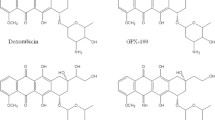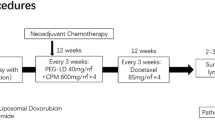Summary
4′-Deoxydoxorubicin (dxDx), a new doxorubicin analogue, was administered intravenously on a 3-week schedule to 73 patients affected by advanced malignant neoplasms. Sixty-five patients, treated with eight dose levels ranging from 10 to 45 mg/m2, were evaluable. The dose-limiting toxicity was myelosuppression, mainly leukopenia. About one third of the patients complained of vomiting which was almost always mild. Minimal hair loss was also documented in about 40% of patients. No hepatic or renal toxicity was observed. Transient and aspecific electrocardiographic changes were recorded in 6% of patients after 1 h and in 3% after 24 h from drug injection. Left ventricular ejection fraction was decreased in two patients after a cumulative dose of 90 mg/m2. One patient died with cardiorespiratory insufficiency and his initial cardiovascular disease might have been aggravated by dxDx. No changes in myocardial function parameters were documented in 18 patients who reached higher cumulative doses, i.e. ≥ 100 mg/m2 and ≥ 200 mg/m2. The highest total dose administered in this study was 340 mg/m2. Therapeutic activity was observed with doses ranging from 25 to 45 mg/m2. Partial response was documented in pancreatic, colon, anal and breast carcinomas as well as in non-Hodgkin's lymphoma. Minor response was observed in prostatic, thyroid, and renal carcinomas as well as in chronic lymphocytic leukemia. The maximum tolerated dose was assessed to be between 40 and 45 mg/m2. A Phase II trial is ongoing utilizing the dose of 35 mg/m2 every 3 weeks.
Similar content being viewed by others
References
Arcamone F, Penco S, Redaelli S: Synthesis and antitumor activity of 4′-deoxydaunorubicin and 4′-deoxyadriamycin. J Med Chem 19:1424, 1976
Di Marco A, Casazza AM, Dasdia T, Necco A, Pratesi G, Rivolta P, Velcich A, Zaccara A, Zunino F: Changes of activity of daunorubicin, adriamycin and stereoisomers following the introduction or removal of hydroxyl groups in the aminosugar moiety. Chem Biol Interactions 19:291–302, 1977
Casazza AM, Di Marco A, Bonadonna G, Bonfante V, Bertazzoli C, Bellini O, Pratesi G, Sala L, Ballerini L: Effects of modifications in position 4 of the chromophore or in position 4′ of the aminosugar on the antitumor activity and toxicity of daunorubicin and doxorubicin. In Crooke ST, Reich ST (eds): Anthracyclines: Current Status and New Developments. Academic Press, New York, 1980, pp 403–430
Casazza AM, Savi G, Pratesi G, Di Marco A: Antitumor activity in mice of 4′-deoxydoxorubicin in comparison with doxorubicin. Eur J Cancer Clin Oncol 19:411–418, 1983
Giuliani FC, Coirin AK, Rene Rice M, Kaplan NO: Effect of 4′-doxorubicin analogs on heterotransplantation of human tumors in congenitally athymic mice. Cancer Treat Rep 65:1063–1075, 1981
Giuliani FC, Kaplan NO: New doxorubicin analogs active against doxorubicin resistant colon tumor xenografts in the nude mouse. Cancer Research 40:4682–4687, 1980
Giuliani FC, Karimullah AZ, Kaplan NO, Goldin A:Chemotherapy of human colorectal tumor xenografts in athimic mice with clinically active drugs: 5-fluorouracil and 1–3 bis-(-2-chloroethyl)-1-nitrosourea (BCNU). Comparison with doxorubicin derivatives: 4′-deoxydoxorubicin and 4′-0-methyl-doxorubicin. Int J Cancer 27:5–13, 1981
Salmon SE, Liu RM, Casazza AM: Evaluation of new anthracycline analogs with the human tumor stem cell assay. Cancer Chemother Pharmacol 6:103–110, 1981
Formelli F, Pollini C, Casazza AM, Di Marco A, Mariani A: Fluorescence assay and pharmacokinetic studies of 4′-deoxy-doxorubicin and doxorubicin in organs of mice bearing solid tumors. Cancer Chemother Pharmacol 5:139–144, 1981
WHO Handbook for Reporting Results of Cancer Treatment. World Health Organization, Geneva, 1979
Bonfante V, Bonadonna G, Villani F, Di Fronzo G, Martini A, Casazza AM: Preliminary phase I study of 4′-epiadriamycin. Cancer Treat Rep 63:915–918, 1979
Bonfante V, Villani F, Bonadonna G: Toxic and therapeutic activity of 4′-epidoxorubicin. Tumori 68:105–111, 1982
Bonfante V, Ferrari L, Villani F, Bonadonna G: Phase I study of 4-demethoxydaunorubicin. Invest N Drugs 1:161–168, 1983
Piccart M, Rozencweig M, Nicaise C, Beer M, Crespeigne N, Anton Aparicio L, Van Rijnenant M, Kenis Y: Phase I trial of 4′-deoxydoxorubicin with a single dose schedule. (Abstr) Proc Am Assoc Cancer Res 24:163, 1983
Sessa C, Kaplan S, Kaplan E, Varini M, Cavalli F: Phase I trial of iv weekly 4′-deoxydoxorubicin. (Abstr) Proc Am Soc Clin Oncol 2:24, 1983
Stanton GF, Wittes RE, Raymond V, Budman D, Shulman P, Kelsen D, Young CW: 4′-Deoxydoxorubicin: a phase I trial in patients with advanced cancer. (Abstr) Proc Am Assoc Cancer Res 24:153, 1983
Author information
Authors and Affiliations
Rights and permissions
About this article
Cite this article
Ferrari, L., Rossi, A., Brambilla, C. et al. Phase I study with 4′ -deoxydoxorubicin. Invest New Drugs 2, 287–295 (1984). https://doi.org/10.1007/BF00175379
Issue Date:
DOI: https://doi.org/10.1007/BF00175379




